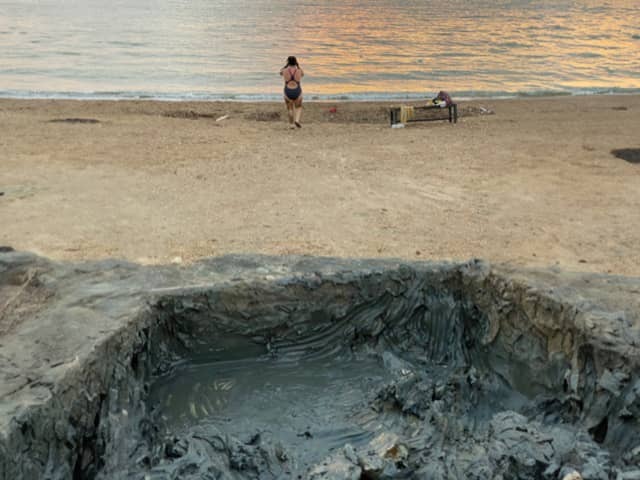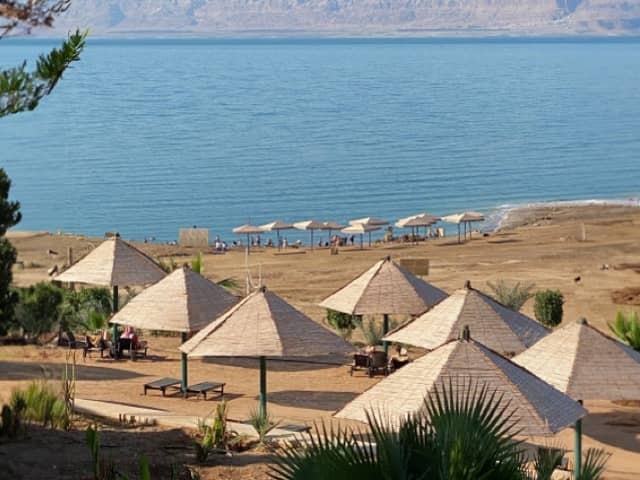Main menu
Common skin conditions

NEWS
Join DermNet PRO
Read more
Quick links
Balneotherapy — extra information
Balneotherapy
Author: Dr Cathlyna Saavedra, House Officer, Middlemore Hospital, Auckland, New Zealand. DermNet Chief Editor in Chief: Adjunct A/Prof Dr Amanda Oakley, Dermatologist, Hamilton, New Zealand. Copy edited by Gus Mitchell. May 2020.
Introduction Uses How to use Process Effectiveness How it works Contraindications Benefits Disadvantages Side effects and risks
What is balneotherapy?
Balneotherapy is the treatment of disease by bathing in thermal mineral waters. Balneotherapy has been widely used for centuries, particularly for the treatment of chronic skin and musculoskeletal conditions. It experienced a decline in popularity in the last century due to the emergence of new pharmacological agents but is now regaining interest as an alternative or complementary treatment option with minimal side effects.
It can be combined with other treatments such as physical therapy or exercise, and mud packs. When combined with exposure to ultraviolet (UV) radiation (phototherapy), the treatment is known as balneophototherapy.
Swimming in the Dead Sea

Dead Sea mud therapy
Mud therapy
Who uses balneotherapy?
Balneotherapy is used for the treatment of chronic inflammatory conditions particularly skin conditions such as psoriasis and atopic dermatitis, and rheumatological conditions.
How is balneotherapy done?
Traditional balneotherapy involves bathing in waters of naturally-occurring mineral springs; well known sites include the Dead Sea in Israel and Jordan, the Kangal Hot Springs in Turkey, and the Blue Lagoon in Iceland. Balneotherapy is also offered by spas or treatment centres using naturally-sourced mineral water or synthetic salt solutions. A simple form of balneotherapy can be done at home by dissolving minerals or salts in baths, such as sea salts and Epsom salts (magnesium sulfate).

Dead Sea Spa
Dead Sea balneotherapy
Dead Sea salts for sale
How is balneotherapy carried out?
The practice of balneotherapy is centre-specific with no standardised treatment regimen. The waters used for balneotherapy vary in temperature (typically 30–40C) and mineral and chemical composition (bicarbonate, sulfate, sulphide, chloride, magnesium, and other metals and minerals). There is no standard duration or frequency of immersion, and variable treatment cycles of days, weeks or months.
Balneophototherapy combines bathing with sun exposure or UVB phototherapy. Balneophotochemotherapy (bathwater PUVA) combines bathing in a psoralen solution followed by exposure to an artificial source of UVA.
When is balneotherapy effective as a treatment?
The heterogeneity of treatment regimens (different water composition, temperature, environment, and duration of therapy), small study sample sizes, and lack of blinded randomised controlled trials (and therefore bias and possible placebo effect) make it difficult to determine the true efficacy and benefit of balneotherapy. A well-studied but extreme example is the hypersaline Dead Sea 400 m below sea level. At this site there is less ultraviolet radiation, of which a greater proportion is UVA, than seen at sea level. This may enhance the value of exposure to natural sunlight while reducing the risk of sunburn.
Balneotherapy use in dermatology has been mainly for chronic plaque psoriasis. A beneficial effect is also seen on associated chronic psoriatic arthritis. Atopic dermatitis can be treated successfully with balneotherapy, especially given its relative safety in children. Natural sunlight balneophototherapy is commonly used to treat vitiligo at the Dead Sea.
Many other dermatologic conditions have been treated with only small numbers reported including:
- Acne vulgaris
- Mycosis fungoides
- Radiation dermatitis
- Ichthyosis
- Seborrhoeic dermatitis
- Urticaria pigmentosa
- Pityriasis rubra pilaris.
Chronic inflammatory joint diseases have been well studied with good responses.
How does balneotherapy work?
The underlying therapeutic mechanism of balneotherapy is not fully understood and is difficult to determine given the variability in treatments. Many studies have been on in vitro cell culture systems, which do not necessarily represent the full organism.
Thermal effects that may be therapeutic include:
- Temperature-induced vasodilation in the skin
- Release of beta-endorphins and enkephalins
- Immune suppression in the skin.
The effects of the mineral salts vary with the actual chemical although it is likely the effects are restricted to the skin surface as percutaneous absorption is probably minimal. Examples include:
- Sulphur has a keratolytic effect, increases oxygen radicals in the skin, and has an immunosuppressant effect
- Magnesium reduces antigen presentation by Langerhans cells
- Bactericidal effects reduce skin surface Staph. aureus carriage.
What are the contraindications to balneotherapy?
Balneotherapy is contraindicated in the following dermatological conditions:
- Acute atopic dermatitis flares
- Weeping lesions such as acute eczema and blistering diseases
- Pustular psoriasis and erythrodermic psoriasis
- Acute skin infections
- Open wounds or skin ulcers.
Balneophototherapy should not be used for patients with systemic lupus erythematosus (SLE) or other photoaggravated dermatoses, skin malignancies, or immunodeficiency syndromes.
Other general contraindications to balneotherapy include:
- Epilepsy
- Cardiovascular diseases, including arrhythmias and congestive heart failure
- Recent stroke or heart attack
- Severe hypertension or hypotension
- Severe anaemia
- Difficulties with balance
- Acute inflammatory conditions such as acute arthritis
- Hypersensitivity to mineral baths
- Severe psychiatric disorder
- Drug or alcohol intoxication.
What are the benefits of balneotherapy?
Compared to standard medical treatments, there are minimal side-effects to balneotherapy. If balneotherapy is effective in symptom control, it can reduce the requirements for medications and thus the side-effects of these medications.
Balneotherapy can be used in conjunction with conventional medical treatment and other therapies, such as physical therapy or phototherapy. Psychological and physical benefits include relaxation, stress management, and improvements in sleep and mood.
What are the disadvantages of balneotherapy?
Balneotherapy is usually privately-funded, as it is not considered a conventional medical treatment option. Access to out-of-home balneotherapy is dependent on the availability of local treatment centres and natural springs. Balneotherapy can be costly and time-consuming.
What are the side effects and risks of balneotherapy?
Balneotherapy is generally safe with minimal side-effects. Side effects can include:
- Skin irritation and itching
- Infections such as Pseudomonas folliculitis (spa pool folliculitis)
- Exfoliative dermatitis
- Hypotension and fainting with prolonged immersion
- Scalds and burns if done at inappropriately high temperatures
- Thermal reaction - exacerbation of joint pain and fatigue.
Balneophototherapy can result in sunburn and exacerbation of photodermatoses.
References
- Huang A, Seité S, Adar T. The use of balneotherapy in dermatology. Clin Dermatol. 2018;36(3):363–8. doi:10.1016/j.clindermatol.2018.03.010. PubMed
- Nasermoaddeli A, Kagamimori S. Balneotherapy in medicine: A review. Environ Health Prev Med. 2005;10(4):171–9. doi:10.1007/BF02897707. PubMed Central
- Cozzi F, Ciprian L, Carrara M, et al. Balneotherapy in chronic inflammatory rheumatic diseases-a narrative review. Int J Biometeorol. 2018;62(12):2065–71. doi:10.1007/s00484-018-1618-z. PubMed
- Farina S, Gisondi P, Zanoni M, et al. Balneotherapy for atopic dermatitis in children at Comano spa in Trentino, Italy. J Dermatolog Treat. 2011;22(6):366–71. doi:10.3109/09546634.2010.512950. PubMed
- Latorre-Román PÁ, Rentero-Blanco M, Laredo-Aguilera JA, García-Pinillos F. Effect of a 12-day balneotherapy programme on pain, mood, sleep, and depression in healthy elderly people. Psychogeriatrics. 2015;15(1):14–19. doi:10.1111/psyg.12068. PubMed
- Halevy S, Sukenik S. Different modalities of spa therapy for skin diseases at the Dead Sea area. Arch Dermatol. 1998;134(11):1416–20. doi:10.1001/archderm.134.11.1416. PubMed
On DermNet
- Spa pool folliculitis
- Psoriasis
- Treatment of psoriasis
- Atopic dermatitis
- Treatment of atopic dermatitis
- Phototherapy
- Miscellaneous treatments and procedures to treat the skin
Other websites
- Balneotherapy — Science Direct
